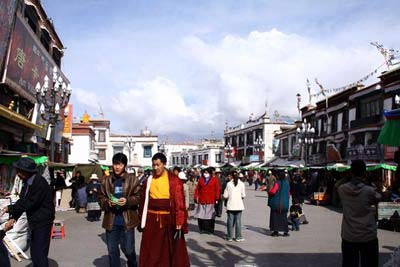
 Covering an area of 29,000 square km, Lhasa is the capital of the autonomous region of Tibet. It is located in southeastern Tibet in the Himalayas, close to China's border with Nepal. The city is situated on the Lhasa River, a tributary of the Brahmaputra River, on a fertile plain almost 3,660 meters (almost 12,010 ft) above sea level, making it one of the world's highest cities. Lhasa is called the "City of Sun," because of its excellent sunshine at such a high altitude.
Covering an area of 29,000 square km, Lhasa is the capital of the autonomous region of Tibet. It is located in southeastern Tibet in the Himalayas, close to China's border with Nepal. The city is situated on the Lhasa River, a tributary of the Brahmaputra River, on a fertile plain almost 3,660 meters (almost 12,010 ft) above sea level, making it one of the world's highest cities. Lhasa is called the "City of Sun," because of its excellent sunshine at such a high altitude.
Climate
Lhasa has a plateau monsoon climate in the temperate zone, with an average annual temperature of 7.5 degrees Celsius and an average annual precipitation of 454 mm. This area is fairly inaccessible for tourists between December and January due to heavy snowfall and poor weather conditions. The coldest time here is January when temperatures can drop to minus 10 degrees Celsius. August is the rainy season when landslides are common. The hottest month is June, with temperatures around 22 degrees Celsius. The sun can be very strong too, so make sure you take plenty of sun block and a hat to protect you from the harsh rays.
The Tibetan plateau is known as the third pole for having the largest concentration of glaciers outside the polar caps. These glaciers are the water source for one sixth of humanity. Scientists predict 80% of these glaciers will disappear within 30 years if current warming continues. The Himalayan glaciers on the Tibetan plateau have been among the most effected by global warming. The Himalayas contain a hundred times as much ice as the Alps. Seven Asian River systems originate on the Tibetan plateau and much of Asia depends on these and the monsoon rains that cross the Himalaya for irrigating agricultural land and drinking water.
Trade and Agriculture
Lhasa is the primary Tibetan trade center, connected by highway with the Chinese provinces of Qinghai, Sichuan, and Xinjiang Uygur Autonomous Regions, and with India, Kashmir, and Nepal. Manufactured goods include food products, textiles, chemicals, electrical equipment, carpets and wool and leather products. There are many animals and fish in Lhasa. The area abounds in mineral resources, with copper, iron, gold, granite, and marble. Agriculture is also important, mainly wheat, highland barley, tomatoes, and cucumbers.
 Population and Culture
Population and Culture
The city has grown rapidly since the 1960s with a current population of 400,000, and the majority of the population is now Chinese. The heart and soul of Tibet, Lhasa is home to many of the region's heritage sites. The city's most famous landmark is the Potala Palace, an enormous palace built on a ridge overlooking the northern part of the city. It is the former residence of the Dalai Lama, who is the spiritual leader of Buddhist Tibetans.

